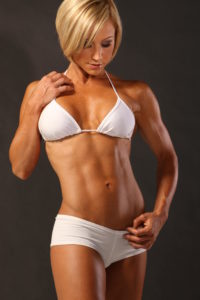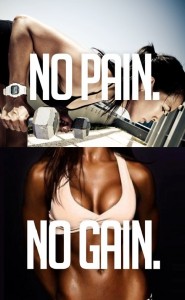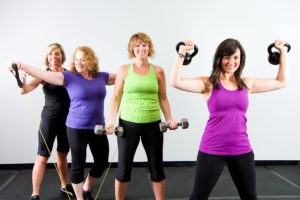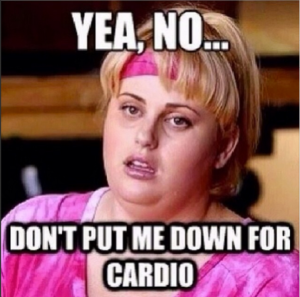The 5 Biggest Lies The Fitness Industry Doesn’t Want You To Know
My Love/Hate Relationship With The Fitness Industry
Currently I have a love/hate relationship with the state of the Fitness Industry. I have lovingly invested almost 2 decades of my life to this space and I’m not encouraged by what I am seeing.
Thank God there are some great coaches out there doing great things. They too are dedicated to helping people experience self-improvement, health and performance.
From these Fitness greats you will hear commonsense messaging. Messages that contain concepts like ‘consistency’, ‘moderation’, ‘sustainability’ and ‘simplicity’. They are client-centric and in the business of helping people become their best. These coaches aim to empower their client.
But here’s the catch – that stuff isn’t that sexy. “Moderation” isn’t sexy nor is it something that can be profited off in the short term. What is sexy is the promise of ‘quick fixes’ and extreme fat loss made easy.
The fitness industry is worth $1b a year in Australia and globally, worth multi billions. Your personal desire to be smaller, fitter, faster, stronger or sexier fuels this boom.
Not that there is anything wrong with wanting to look and feel sexy AF. Sculpting a body you are proud of is a worthwhile pursuit if coming from a place of robust self-esteem.
Sadly though, this is not the case for most women.
In a Dove sponsored survey of more than 10,000 women it was revealed that 80% of women hated their bodies. That means only 2 out of 10 women LIKE their body! Based on that statistic not many of your friends like their body.
This extreme body-dissatisfaction lines gyms, fat loss companies, magazines, and some ‘professionals’ pockets.
If you haven’t stopped to think about that you should.
They all profit off your body hatred. They feed on your insecurity and they rely on your failure. A closer look at a Gym business model reveals this. A gym may have 2000 paying members but only small fraction of that turn up. Given that more than 50% of gym members don’t use their membership it is a win for the clubs. If you do not turn up to use the gym you are DONATING to them.
Clubs and gyms aren’t all to blame. Some are doing a good job at improving the member experience. The majority aren’t. Weight loss companies are the worst culprits followed up by the gazillion supplement companies.
Sounds awful but if we scrape past all the glossy motivational memes and the perfectly buffed bodies we will see the truth.
The industry that says it’s about helping you become your best is actually keeping you down. This has been perpetuated by certain lies that have convinced you otherwise.
In coaching we often talk about Limiting Beliefs. You may have heard of them before. Certain beliefs will hold a person back by keeping them in a particular way of behaving. The first step in transforming limiting beliefs is to create awareness of them. If you aren’t aware of something you can’t do anything about it.
The aim here is to make you aware of the most common lies so that you can challenge these beliefs and become empowered to take ownership of your success.
Lie #1: Being super lean equates to being healthy.
This is my biggest peeve. Clever marketing campaigns and social media exposure have normalised images of women with rocking 6 packs, big booties and ripped shoulders.
The ‘perfect fitness’ body shape is now the ‘ideal’ shape that many women aspire to have. Unfortunately it is neither healthy nor realistic.
Some women are genetically lean and have a 6 pack regardless of what they eat or how they exercise. They could eat burgers everyday and still have a rocking body. They are also called ‘outliers’. Called that because outliers lie, well, on the outside of normal. They are at the skinny ends of the bell curve.
As such they land the lucrative sports modeling jobs or create their own fame on Instagram. (see Lie #5)
We see them and we want to look like them.
Isn’t it crazy to think that the majority of us ‘middle of the bell curve’ people, are trying to make our bodies ‘fit’ the shape of a select few? You can’t make a square peg fit a round hole people.
But of course we are lead to believe that if we train and diet hard enough we CAN get there. All you need is a little willpower and motivation and boom the body of your dreams awaits (oh, and if you fail it’s clearly due to your lack of willpower). Yes, hard work is important but so too is knowing what your body is realistically capable of achieving.
Let’s talk about these fitness models. It is their JOB to stay lean all year round! Their income depends on them being ’shoot’ ready. Genetics aside, these women work hard for their body. It is the result of years of rigorous training and disciplined eating regimes. But yet, it comes at a physical, social and emotional cost.

Case in point Jamie Eason professional fitness model
Like professional athletes they make certain sacrifices to maintain their look. It is their livelihood. Keep that front of mind when you are trying to slog you way to a ‘perfect sports-model-inspired body’, whilst juggling a family, partner, job and other life demands
(here’s an example of a well balanced, results based program that doesn’t take over your life)
Now, back to the health piece. Whilst a lean body has become the norm it doesn’t make it healthy.
For a woman’s body to function healthily it needs a certain amount of body fat. Generally speaking between 19 – 30% body fat is a good place to be. This range is an optimal range for general health (with individual variations occurring).
As a woman starts to drop lower in body fat her body undergoes hormonal shifts. Her decrease in body fat may be due to a decrease in calorie consumption, an increased in energy expenditure of a combination of both. Any one of these 3 factors will have a different effect on her system.
When her body fat percentage becomes too low she loses her menstrual cycle, which will happen at different percentages for different women. A loss of a cycle due to these conditions is called Athletic Amenorrhea and is a cause for concern.
Athletic Amonorrhea is associated with Osteoporosis and disordered eating. It also affects Thyroid health, cognitive thinking, mood and fertility.
Is being super lean worth those risks?
Lie #2: You have to sweat and annihilate yourself to get results.
Let’s put this elitist, wankery lie to rest now (read about The Wankerfication Of The Fitness Industry here). Unless you are a secret sadomasochistic freak who gets off on pain there is absolutely NO need to punish yourself in a workout! The ‘no pain, no gain’ philosophy that permeates our industry has to die.

SO MUCH WRONG IN THIS ‘FITSPIRATION’ IMAGE
Pushing yourself past pain to the point of complete exhaustion and annihilation does not deserve a badge of honour.
It’s wasted energy. And it’s dumb.
To achieve any sort of result it is necessary to put in effort. You can’t escape that. To increase fitness, strength, power or fat loss you have to stress the body into adaptation. But it needn’t be punishing.
Smart training uses progressive overload and appropriate intensity to stimulate the body to change. That’s exercise prescription 101.
A good work out doesn’t always leave you broken and covered in sweat. A good work out is one that takes you closer to your goal in a well thought out manner.
Some sessions may produce a sweat response whereas others don’t. A good stretch session isn’t high in intensity but it is crucial for recovery, which is crucial for results.
A solid ‘meat and potato’ weight lifting session might not having you panting like a dog but it will improve your strength, build muscle and contribute to a healthy metabolism.
Society teaches us that ‘more is better’. This is a blatant lie. When it comes to training more is definitely NOT better. Better is better.
The Goldilocks principle, a term borrowed from the engineering world, explains this beautifully. Do you remember the story of Goldilocks and the 3 bears? She was a felon who broke and entered the bears’ house. I will never understand why they didn’t try to eat her … I digress. The point is that she was looking for the ‘right’ porridge. Not too hot, and not too cold. The Goldilocks principle states “something must fall within certain margins as opposed to reaching extremes”.
This rule plays out in most things in our life. If we don’t eat enough we starve, if we eat too much we put on weight. If we sleep to little we don’t function, if we sleep too much we also don’t function.
Exercise is the same – too little exercise is a health issue. Too much exercise is also a health issue. You need to find the exercise sweet spot.
Lie #3: Women should train like men.
Wait whhhhhaaaattttt? How is this a lie Nardia? Before you get pissed off at me allow me to wrap this up in my favourite word – context.
Women are MORE than capable of being strong, lifting heavy and doing all the things that men can do. That’s a total no-brainer. This is not about capability.
What I am proposing is we tweak training parameters to match our hormonal profile to get better outcomes. In case anyone has forgotten we are not smaller versions of men with breasts but the industry thinks so.
To understand this we need to go back in history. Men, for men, have built the entire fitness industry. Men using men subjects have done the majority of fitness/exercise physiology studies. As such there is a strong bias towards men.
A study published in the European Journal of Sports Science in 2014 dived into this topic. The researchers analysed 1382 articles from popular journals over a 3-year to look for the number of women subjects used. Unsurprisingly women were severely underrepresented. Only 39% of subjects were female compared to the 61% of males.
Translation: there is much that we don’t know about women, sex hormones and exercise.
Thankfully the tide is changing. More women (and men) scientists are taking a vested interest in women’s health. Exciting research is being conducted that will have positive implications for us ladies (read here about training with your Menstrual cycle)
Men’s hormonal profiles remain relatively stable across the ages, whereas women’s do not. If you are a woman you know exactly what I am talking about. Our hormone Estrogen handles our and wellbeing, body shape, fertility and mood. It fluctuates depending on our age and stage of life.
When we are young we may prefer a certain type of exercise or training. As we move through the decades, from pre-pregnancy to post-pregnancy and through to menopause different exercise considerations are needed.

A woman who leaks pee when jumping rope is suffering from pelvic floor dysfunction and needs specific help. Telling her to Squat heavy will NOT benefit her (read about the pelvic floor here)
Women who suffer from period pain should not ‘have to suck it up’ and push through (read here about PMS and Exercise)
A middle-aged woman who has a history of chronic low calorie diets may not be suitably qualified for jumping or plyometric type exercises.
Someone who is experiencing high levels of stress in her professional and personal life, trains like a demon and is failing to sleep will have a Sympathetic nervous system issue. She needs to restore her body rather than smash it with hardcore exercise.
These are just some of the many, and all too common examples where a female body requires specialized consideration.
To get the best outcomes for yourself learn how to work with your body, not against it. Learn to become the expert in yourself so that you can make the best choices for your body
Lie #4: Low intensity Cardio will make you fat
Poor ‘cardio’ – it has been completely taken out of context and demonized.
Things fall in and out of fashion in the industry. As they cycle around a pendulum effect occurs. We tend to swing from one extreme to another until we land in the middle. Remember how we went from the extremes of ‘anit-fat’ to the ‘anti-carb’ movement? Well, ‘cardio’ is in the returning swing phase. Like my 1990 Doc Marten boots, ‘conventional’ cardio is back in fashion people.

I seriously have these items in my wardrobe…
However, there is a BIG caveat to this statement that I’ll get to shortly.
‘Cardio’ is the nickname given to any type of activity that elevates the heart for a period of time. The Cardio-Vascular system is the system that involves the heart, the blood vessels and the muscles that the vessels supply.
The better and stronger this network, the more efficient and fit you become.
Interval training is a form of ‘cardio’ just as is lifting weights. Walking, swimming and running are also forms of ‘cardio-vascular exercise’.
These are all great forms of cardio and each will have a different effect on a specific energy system. We have three different energy tanks that we draw on depending on what we are doing. Each tank or energy system has unique benefits that contribute to how our body functions and performs.
I’ll spare you an in-depth physiology lesson but we have the Anaerobic systems (ATP-PC and Glycolytic) and the Aerobic system.
The type of cardio that has gained a bad reputation is the more endurance type of cardio otherwise referred to as Aerobic conditioning (or Steady State).
The typical ‘cardio-bunny’ who spends hours on their favourite Elliptical machine is working the Aerobic system. This type of training, in the absence of any other training (weight training and intervals) creates an unfavourable hormonal environment that may contribute to fat gain and muscle loss.

Hormones such as Cortisol, Adrenalin, Noreadrenalin and Growth Hormone all affect the way our body looks and functions. They have the power to work for us, or against us depending on the environment (remember the Golidlocks principle?).
Too much Aerobic cardio can have detrimental effects on our body. It can become a stressor, which will result in the release of the hormone Cortisol. This may promote fat storage, increase inflammation and break down muscle tissue.
The exact opposite of what is needed for a healthy (and sexy AF) body. I’m over simplifying a complex topic but this is why it gained a bad reputation.
Another reason is that endurance ‘Cardio’ training was and still is attractive to many women. It is easy to do, and very easy to over do.
Long cardio sessions satisfy the need to see the number of calories burned clock up. If someone is struggling to maintain healthy boundaries with exercise performing ‘cardio’ is an easy way to get their fix.
At then end of the day endurance based cardio workouts are not a problem. The problem lies in the over-doing of it, especially when coupled with a fragile lifestyle (high stress levels, low calorie diets, poor sleep hygiene, poor gut health etc – click here to read about the role of the Gut)
Aerobic conditioning is extremely important and has multiple benefits. It improves heart health, improves fat burning, reduces stress and anxiety, improves muscular endurance and supports the other energy systems.
Put simply ‘cardio’ will NOT make you fat especially when combined with a well thought out training program.
All women benefit from doing 2-3 weights sessions per week, some huffy puffy sessions, an Aerobic conditioning session and a ton of walking . (Click here to access a complete FREE 4 Week training program)
Lie #5: Your favourite online “Insta-Coach”/”PT” knows what s/he is talking about.
Taking advice from an online Insta-coach or celebrity who does NOT have qualifications or has never been a trainer is a recipe for DISASTER!
Just because someone can create a perfectly curated Insta-feed does not qualify him or her for dishing out advice. Just because they are great at self-promotion does not make them a good coach. And here’s the big one – just because they have a good body it does not make them credible (click here to read one of my all time favourite blog posts about this subject from a super smart lady)
You need to look beyond their photos to find this person’s credentials and experience. Questions such as “Where did they study?” and “do they have a relevant fitness qualification?” are a good first step.
Find out how long they have been in the industry, and whether they have worked with real humans. Does this “coach” give solid evidence-based information to help you live better or is it all about them?
I’ve got a few friends who happen to amazing online coaches. Their business grows through social media and they have big, influential platforms. I also trust them implicitly because they are qualified, experienced and deliver highly valuable content. Their body is their biggest marketing tool AND they have the brains, qualifications and experience to back it.
These examples are far and few between though. The majority of them fall into ‘avoid-at-all-cost’ category.
Become Your Own Expert
And there you have it, the top 5 biggest lies of the Fitness Industry that are holding you back. Now that you have awareness of these lies go ahead and take the opportunity to strengthen your own body wisdom. Focus on becoming the expert in yourself.
Instead of blindly looking out for the answers start to seek the answers from within. Sounds Yoda-esque but at the end of the day YOU know what’s best for you.
Lastly, if you want to learn what should be included in a well balanced training program then click the button below. I have written a complete training program that includes strength sessions, intervals, a circuit and LSD session.
Comments +